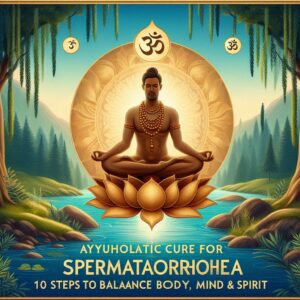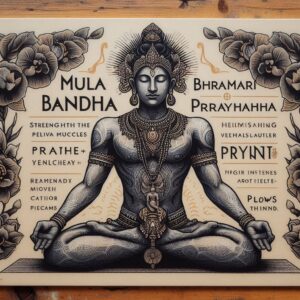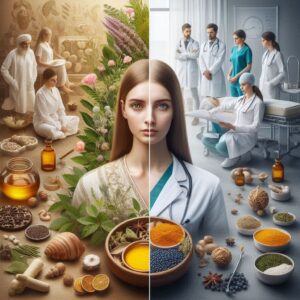Spermatorrhoea Treatment in Ayurveda
Spermatorrhoea—a condition marked by involuntary semen loss—is more than a physical ailment; it’s a silent struggle that intertwines bodily discomfort with emotional distress, often shrouded in shame and misunderstanding. In a world quick to prescribe pills or dismiss symptoms as “all in the mind,” Ayurveda emerges as a beacon of hope, offering not just treatment but transformation. Rooted in 5,000 years of wisdom, Ayurveda views spermatorrhoea not as a standalone issue but as a cry for balance—a disruption in Vata dosha, a depletion of Ojas (vital essence), or a weakened Shukra Dhatu (reproductive tissue).
This artical is your definitive guide to reclaiming control, blending ancient rituals with actionable modern strategies. From potent herbs like Ashwagandha and Shilajit to Panchakarma detox, yoga for pelvic strength, and stress-busting mindfulness, we unravel the secrets to restoring vitality, confidence, and harmony. Whether you’re battling chronic nightfall, fatigue, or the stigma around it, step into a journey to Spermatorrhoea Treatment in Ayurveda where healing is holistic, sustainable, and deeply empowering. Let’s rewrite the narrative—one rooted in nature’s timeless intelligence.

Table of Contents: “Spermatorrhoea Treatment in Ayurveda
- Introduction to Spermatorrhoea: Ayurvedic vs. Modern Perspectives
- Top 5 Ayurvedic Herbs for Seminal Health
- The Ultimate Ayurvedic Diet Plan to Stop Involuntary Discharge
- Yoga & Pranayama: Ancient Practices for Seminal Retention
- Panchakarma Therapies: Detoxifying for Reproductive Health
- Mental Health & Stress Management: Breaking the Anxiety Cycle
- Spermatorrhoea in Teenagers: A Parent’s Ayurvedic Guide
- Ayurveda vs. Allopathy: Cost, Safety & Long-Term Results
- Debunking 10 Myths: Separating Fear from Ayurvedic Truth
- Success Stories & Long-Term Recovery: Real-Life Journeys
Understanding Spermatorrhoea – Ayurvedic vs. Modern Perspectives
Spermatorrhoea, a condition characterized by involuntary semen discharge without sexual arousal, affects countless men globally, particularly those aged 15–40. Spermatorrhoea is also calle धातु रोग or धात रोग in hindi. While modern medicine often dismisses it as a minor issue, Ayurveda views it as a sign of deeper imbalances in the body’s vital energies (doshas) and reproductive tissues (Shukra Dhatu). This article explores how Ayurveda diagnoses and treats spermatorrhoea holistically, contrasting it with modern medical perspectives.
Ayurvedic vs. Modern Definitions
Ayurvedic Perspective
In Ayurveda, spermatorrhoea is rooted in the depletion of Ojas (vital essence) and imbalances in Vata dosha, which governs movement and nervous system functions. Weak Agni (digestive fire) and improper diet lead to toxin accumulation (Ama), disrupting the nourishment of Shukra Dhatu (reproductive tissue).
Key Terms:
- Shukra Dhatu: Reproductive tissue responsible for vitality and fertility.
- Ojas: The essence of immunity and vigor, closely tied to semen health.
Modern Medicine Perspective
Modern science often attributes spermatorrhoea to psychological stress, hormonal imbalances (e.g., low testosterone), or infections like prostatitis. Treatments typically focus on antibiotics, antidepressants, or hormone therapy, addressing symptoms rather than root causes.
Comparison Table:
| Factor | Ayurvedic View | Modern View |
| Root Cause | Vata imbalance, weak Agni, Ojas depletion | Stress, infections, hormonal issues |
| Treatment Focus | Herbs, diet, lifestyle, detox | Medications, psychotherapy |
| Approach | Holistic, preventive | Symptom-based, reactive |
Key Causes of Spermatorrhoea in Ayurveda
- Dosha Imbalances:
- Vata Aggravation: Excessive physical/mental activity, irregular routines, or anxiety dry out tissues, weakening reproductive health.
- Kapha Congestion: Poor diet and sedentary habits lead to mucus buildup, blocking energy channels (Srotas).
- Lifestyle Factors:
- Overindulgence in sex/masturbation.
- Consuming cold, processed, or spicy foods.
- Weak Digestive Fire (Agni):
- Undigested food toxins (Ama) circulate in the body, disrupting Shukra Dhatu
Common Symptoms
- Physical: Frequent nocturnal emissions, lower back pain, fatigue, urinary discomfort.
- Mental: Anxiety, brain fog, lack of concentration.
How Vata and Kapha imbalances contribute to spermatorrhoea.
Why Ayurveda Stands Out
Unlike modern medicine’s temporary fixes, Ayurveda addresses the root cause through:
- Diet: Warming, nourishing foods like ghee, dates, and ashwagandha milk.
- Lifestyle: Yoga, meditation, and regulated sleep patterns.
- Detox Therapies: Panchakarma to cleanse toxins and restore dosha balance.
Key Takeaways
- Spermatorrhoea in Ayurveda signals deeper imbalances in Vataand Agni.
- Modern medicine focuses on symptoms, while Ayurveda offers holistic healing.
- Strengthening Ojasthrough diet and herbs is critical for recovery.
A balanced approach combining Ayurveda and modern care yields the best results.
Top 5 Ayurvedic Herbs for Spermatorrhoea
Ayurveda offers a treasure trove of herbs to address spermatorrhoea by balancing doshas, nourishing Shukra Dhatu (reproductive tissue), and strengthening Ojas (vital energy). In this article, we explore the top 5 herbs backed by both ancient wisdom and modern research to combat involuntary semen loss and boost overall vitality.
-
Ashwagandha: The Stress-Busting Rejuvenator
Benefits:
- Balances Vata dosha, reducing anxiety and fatigue.
- Enhances Shukra Dhatu quality and sperm count.
- Improves stamina and hormonal balance.
How It Works:
Ashwagandha’s adaptogenic properties reduce cortisol (stress hormone) levels, which are often linked to semen loss. It also boosts testosterone and supports healthy sperm production.
Dosage:
- Powder: ½–1 tsp with warm milk before bed.
- Capsules: 300–500 mg daily.
Precautions:
- Avoid with sedatives or thyroid medications.
- Excessive use may cause digestive discomfort.
Ashwagandha’s role in balancing hormones and reducing stress.
-
Shilajit: The Mineral-Rich Revitalizer
Benefits:
- Rich in fulvic acid and 84+ trace minerals.
- Boosts testosterone and energy levels.
- Enhances nutrient absorption for stronger Shukra Dhatu.
How It Works:
Shilajit detoxifies tissues, improves mitochondrial function, and supports healthy sperm motility.
Dosage:
- Resin: 300–500 mg dissolved in warm water/milk.
- Capsules: 250 mg twice daily.
Precautions:
- Ensure purity (avoid adulterated products).
- Not recommended for those with heavy metal toxicity.
Testing Shilajit purity using water solubility.
-
Safed Musli: The Natural Aphrodisiac
Benefits:
- Acts as a Vajikarana (aphrodisiac) herb.
- Improves stamina and muscle strength.
- Enhances sexual performance and semen density.
How It Works:
Safed Musli increases luteinizing hormone (LH) production, which stimulates testosterone synthesis.
Dosage:
- Powder: 3–5 grams with milk twice daily.
- Capsules: 500 mg post meals.
Precautions:
- May lower blood sugar; avoid if diabetic.
Traditional uses of Safed Musli in Ayurvedic tonics.
-
Gokshura: The Urinary & Reproductive Tonic
Benefits:
- Balances Kapha and Vata doshas.
- Supports urinary tract health and reduces inflammation.
- Enhances libido and sperm motility.
How It Works:
Gokshura (Tribulus terrestris) boosts nitric oxide production, improving blood flow to reproductive organs.
Dosage:
- Powder: 3–6 grams with honey.
- Tea: Steep 1 tsp dried herb in hot water.
Precautions:
- Avoid with diuretics or blood pressure medications.
Gokshura’s dual action on urinary and reproductive systems
- Akarkara (Anacyclus pyrethrum) This herb has a calming effect on the nervous systemBenefits:
- Improves Improving sperm count and motility.
- Reduces swelling and inflammation in the genital area.
- Help alleviate anxiety and stress-related issues contributing to spermatorrhoea
How It Works:
Akarkara has anti-inflammatory properties, which help alleviate anxiety and stress-related issues contributing to spermatorrhoea.
Dosage:
- Powder: Powder: Mix 1-2 teaspoons of Akarkara powder with warm water or milk, twice a day.
- Capsules: Take 1-2 capsules (containing 500-1000 mg of Akarkara extract) twice a day.
- Decoction: Boil 1-2 teaspoons of dried Akarkara roots in water, then strain and drink twice a day.
Precautions:
- Akarkara may interact with certain drugs
-
Kapikacchu (Mucuna pruriens): The Dopamine Booster
Benefits:
- High in L-DOPA, a precursor to dopamine.
- Enhances mood, libido, and sperm count.
- Reduces oxidative stress in reproductive tissues.
How It Works:
Kapikacchu regulates prolactin levels, which are often elevated in stress-induced spermatorrhoea.
Mucuna pruriens dopamine-boosting effects helps to cure erectile dysfunction
Dosage:
- Powder: 5 grams with milk.
- Capsules: 400–600 mg daily.
Precautions:
- May cause nausea if taken on an empty stomach.
Kapikacchu’s role in balancing brain chemistry and libido
Herb Comparison Table
| Herb | Key Benefit | Best For | Dosage Form |
| Ashwagandha | Stress reduction, hormonal balance | Anxiety-driven semen loss | Powder/Capsules |
| Shilajit | Energy, testosterone boost | Chronic fatigue, low libido | Resin/Capsules |
| Safed Musli | Stamina, muscle strength | Physical weakness | Powder/Milk decoction |
| Gokshura | Urinary health, blood flow | Inflammation, low motility | Tea/Powder |
| Kapikacchu | Mood enhancement, sperm count | Stress-related spermatorrhoea | Powder/Capsules |
Key Takeaways
- Ashwagandhaand Shilajit are ideal for stress-related semen loss.
- Safed Musliand Gokshura enhance physical stamina and urinary health.
- Kapikacchuaddresses both mood and sperm quality.
Quick guide to choosing the right herb for your symptoms.
Ayurvedic Diet Plan to Stop Involuntary Seminal Discharge
In Ayurveda, diet is the cornerstone of healing. Spermatorrhoea, linked to weakened Shukra Dhatu (reproductive tissue) and Agni (digestive fire), demands a strategic dietary approach. This guide outlines what to eat, what to avoid, and how to nourish your body to restore vitality and prevent involuntary semen discharge.
The Sattvic Diet: Foundation of Seminal Health
A Sattvic diet emphasizes purity, balance, and nourishment. It calms the mind, strengthens digestion, and fuels Ojas (vital essence). Key principles:
- Warm, Cooked Foods: Easy to digest and kindle Agni.
- Fresh & Organic: Avoid processed, frozen, or leftover foods.
- Mindful Eating: Eat in a calm environment, chewing thoroughly.
Foods to Avoid
Certain foods aggravate Vata (dryness) or Kapha (congestion), worsening spermatorrhoea:
- Cold & Raw Foods
- Ice cream, salads, smoothies.
- Why?Dampen Agni, causing undigested toxins (Ama).
- Spicy, Salty, Sour Foods
- Chili, pickles, processed snacks.
- Why?Overstimulate the body, increasing heat (Pitta) and irritation.
- Non-Vegetarian Foods
- Red meat, eggs, seafood.
- Why?Heavy to digest, increase Tamas (lethargy).
- Caffeine & Alcohol
- Coffee, energy drinks, beer.
- Why?Dehydrate tissues and destabilize Vata.
Processed, cold, and spicy foods disrupt digestion and semen health.
Best Foods for Seminal Health
Incorporate these Shukra Dhatu-nourishing foods:
1. Warm Milk with Herbs
- Recipe: Boil 1 cup milk with ¼ tsp Ashwagandha, 1 crushed cardamom pod.
- Benefits: Replenishes Ojas, calms Vata.
2. Ghee (Clarified Butter)
- How to Use: 1 tsp daily in rice, dals, or warm water.
- Benefits: Lubricates tissues, boosts nerve strength.
3. Dates & Figs
- How to Eat: Soak 2–3 overnight; consume with milk.
- Benefits: Rich in iron and magnesium for energy.
4. Pumpkin Seeds & Almonds
- How to Eat: Soak 10 almonds overnight; blend into milk.
- Benefits: High in zinc, supports testosterone.
5. Whole Grains
- Examples: Brown rice, quinoa, oats.
- Benefits: Sustain energy, stabilize blood sugar.
Sample Daily Meal Plan
| Time | Meal | Key Benefits |
| 7 AM | Warm water with lemon + soaked almonds | Detoxifies, boosts Agni |
| 8 AM | Oatmeal with ghee and figs | Sustained energy, Vata balance |
| 12 PM | Khichdi (mung dal + rice) with steamed veggies | Light, easy digestion |
| 4 PM | Herbal tea (ginger + cumin) + pumpkin seeds | Reduces bloating, nourishes |
| 7 PM | Roti with spinach curry + warm milk | Iron-rich, promotes sleep |
A balanced day of meals to strengthen Shukra Dhatu.
Recipes for Seminal Strength
1. Ashwagandha Milk
Ingredients:
- 1 cup milk, ½ tsp Ashwagandha powder, 1 tsp ghee, pinch of turmeric.
Method: - Boil milk with herbs; strain and drink before bed.
2. Date & Almond Energy Balls
Ingredients:
- 10 dates, 10 almonds, 1 tsp ghee, cardamom powder.
Method: - Blend ingredients; roll into balls. Eat 1–2 daily.
Key Takeaways
- Avoid: Cold, spicy, and processed foods that weaken Agni.
- Embrace: Warm milk, ghee, nuts, and whole grains to nourish Shukra Dhatu.
- Timing: Eat meals at consistent times to stabilize digestion.
Top foods to include in your Ayurvedic diet.
Yoga & Pranayama for Seminal Retention
In Ayurveda, spermatorrhoea is closely tied to imbalances in Apana Vayu (the downward-moving energy governing elimination and reproduction). Yoga and pranayama restore this energy flow, strengthen pelvic muscles, and calm the mind. This guide reveals 5 transformative practices to lock vital energy (prana) and stop nocturnal emissions naturally.

-
Mula Bandha (Root Lock)
What It Does:
- Strengthens pelvic floor muscles.
- Redirects Apana Vayu upward to nourish reproductive tissues.
Steps:
- Sit in Sukhasana(cross-legged pose).
- Inhale deeply, then exhale fully.
- Contract the muscles at the base of your pelvis (as if stopping urination).
- Hold for 5–10 seconds, then release.
Repetitions: 10 rounds daily.
Activating the root lock to prevent semen loss.
-
Ashwini Mudra (Horse Gesture)
What It Does:
- Tones pelvic organs and prostate.
- Improves bladder control and sexual stamina.
Steps:
- Sit comfortably with a straight spine.
- Rapidly contract and release pelvic floor muscles (like a horse flicking its tail).
- Focus on rhythmic, controlled movements.
Repetitions: 20–30 contractions per session, twice daily.
-
Bhujangasana (Cobra Pose)
What It Does:
- Stimulates the adrenal glands and reproductive organs.
- Relieves lower back pain linked to semen loss.
Steps:
- Lie on your stomach, palms under shoulders.
- Inhale and lift your chest, keeping hips grounded.
- Hold for 15–30 seconds, then exhale and release.
Repetitions: 5–7 rounds daily.
Cobra pose boosts circulation to pelvic organs.
-
Bhramari Pranayama (Bee Breath)
What It Does:
- Calms the mind and reduces stress-induced semen loss.
- Balances hormones by stimulating the pituitary gland.
Steps:
- Sit comfortably, close your eyes, and place index fingers on ear cartilage.
- Inhale deeply, then exhale while humming like a bee.
- Feel vibrations in your skull and chest.
Repetitions: 5–10 rounds before bed.
-
Vajrasana (Thunderbolt Pose)
What It Does:
- Strengthens digestion (Agni) to prevent toxin buildup (Ama).
- Redirects blood flow to pelvic region for tissue repair.
Steps:
- Kneel on the floor, sit back on your heels, and rest hands on thighs.
- Hold for 5–10 minutes post meals.
Tip: Practice after eating to enhance nutrient absorption.
Sample Daily Routine
| Time | Practice | Duration | Benefits |
| 6 AM | Mula Bandha | 5 mins | Pelvic strength |
| 7 AM | Bhujangasana | 10 mins | Reproductive circulation |
| 8 PM | Bhramari Pranayama | 5 mins | Stress reduction |
| 9 PM | Ashwini Mudra | 5 mins | Bladder control |
A balanced routine to harmonize body and mind.
Key Takeaways
- Mula Bandhaand Ashwini Mudra directly strengthen pelvic muscles.
- Bhramari Pranayamareduces stress, a major trigger for semen loss.
- Consistency is key – practice daily for 4–6 weeks for lasting results.
Avoid:
- Overstraining during poses.
- Practicing on a full stomach (except Vajrasana).
Panchakarma Therapies for Chronic Spermatorrhoea
Panchakarma, Ayurveda’s premier detoxification system, offers profound solutions for chronic spermatorrhoea by eliminating toxins (Ama), correcting Vata imbalances, and rejuvenating Shukra Dhatu (reproductive tissue). Unlike superficial treatments, Panchakarma addresses the root cause of involuntary semen loss through therapies like Basti (enema), Virechana (purgation), and Nasya (nasal drops). This article explores how these treatments work and who should consider them.
What is Panchakarma?
Panchakarma (five actions) is a three-stage process:
- Purva Karma: Prepares the body via oil massages (Snehana) and sweating (Swedana).
- Pradhana Karma: Main detox therapies like Basti or Virechana.
- Paschat Karma: Post-treatment diet and lifestyle to restore vitality.
Key Panchakarma Therapies for Spermatorrhoea
1. Basti (Medicated Enema)
What It Does:
- Balances Apana Vayu(downward Vata), the root cause of semen loss.
- Replenishes colon health, which Ayurveda links to reproductive strength.
Types:
- Anuvasana Basti: Oil-based enema with herbs like Ashwagandha or Bala.
- Niruha Basti: Herbal decoction enema with Dashamoola or Guduchi.
Benefits:
- Reduces lower back pain and urinary frequency.
- Strengthens pelvic nerves and muscles.
How Basti cleanses the colon and stabilizes Vata.
2. Virechana (Purgation Therapy)
What It Does:
- Clears excess Pittaand toxins from the liver and blood.
- Resolves heat-related issues like burning ejaculation or inflammation.
Procedure:
- Prep: 3–5 days of ghee ingestion to loosen toxins.
- Purgation: Herbal laxatives (Trivrit lehyam) induce controlled bowel movements.
Who Needs It?:
- Patients with fiery symptoms (anger, acid reflux, red eyes).
3. Nasya (Nasal Therapy)
What It Does:
- Clears blocked energy channels (Srotas) in the head.
- Reduces stress and hormonal imbalances linked to semen loss.
Procedure:
- 2–3 drops of medicated oil (e.g., Brahmi or Anu tailam) are administered into the nostrils.
Benefits:
- Calms the mind, improves sleep, and balances testosterone.
Administering Nasya to harmonize mind-body connection.
Panchakarma Therapy Comparison
| Therapy | Dosha Focus | Key Benefits | Duration |
| Basti | Vata | Strengthens colon, pelvic nerves | 8–15 days |
| Virechana | Pitta | Clears liver toxins, reduces heat | 5–7 days |
| Nasya | Kapha/Vata | Relieves stress, balances hormones | 3–5 days |
Who Should Avoid Panchakarma?
- Contraindications: Severe anemia, pregnancy, or recent surgery.
- Side Effects: Temporary fatigue, mild diarrhea (Virechana).
Pro Tip: Always consult an Ayurvedic doctor (Vaidya) to tailor therapies to your prakriti (body type).
Key Takeaways
- Bastiis ideal for Vata-driven semen loss with back pain or anxiety.
- Virechanatackles Pitta-related inflammation and heat symptoms.
- Nasyacomplements other therapies by stabilizing mental health.
How Panchakarma’s detox-rejuvenate cycle restores Shukra Dhatu.
Mental Health & Stress Management in Spermatorrhoea
Chronic stress and anxiety are silent drivers of spermatorrhoea, disrupting hormonal balance, weakening Ojas (vital energy), and destabilizing Vata dosha. Ayurveda emphasizes the mind-body connection, offering powerful tools to calm the nervous system, reduce cortisol levels, and restore reproductive health. In this article, explore stress-induced spermatorrhoea causes, top Ayurvedic herbs, and mindfulness practices for holistic healing.
Stress & Semen Loss: The Ayurvedic Connection
How Stress Triggers Spermatorrhoea
- Cortisol Overload: Chronic stress elevates cortisol, suppressing testosterone and impairing Shukra Dhatu(reproductive tissue) production.
- Vata Imbalance: Anxiety aggravates Vata dosha, causing erratic energy flow (Apana Vayu) and involuntary semen discharge.
- Weak Agni: Stress weakens digestive fire, leading to Ama(toxins) that block nutrient absorption for Shukra Dhatu.
Chronic stress → Hormonal imbalance → Weak Shukra Dhatu → Semen loss.
Top 3 Ayurvedic Herbs for Stress Relief
1. Brahmi (Bacopa monnieri)
Benefits:
- Calms the mind, enhances focus, and repairs nerve damage.
- Reduces cortisol by 20–25% (studies show).
How to Use:
- Tea: Steep 1 tsp dried Brahmi in hot water.
- Capsules: 300 mg twice daily.
2. Ashwagandha (Withania somnifera)
Benefits:
- Lowers cortisol by 28% (clinical trials).
- Boosts testosterone and sperm motility.
How to Use:
- Powder: ½ tsp with warm milk at bedtime.
Tip: Pair with Shatavari for hormonal balance.
3. Jatamansi (Nardostachys jatamansi)
Benefits:
- Balances neurotransmitters (serotonin, GABA).
- Deep sleep promoter, reducing nocturnal emissions.
How to Use:
- Oil: Massage 5 drops on temples before bed.
- Capsules: 250 mg daily.
Spermatorrhoea Treatment in Ayurveda
Brahmi, Ashwagandha, and Jatamansi dosage and benefits.
Mindfulness & Meditation Practices
1. Yoga Nidra (Psychic Sleep)
Steps:
- Lie in Shavasana(corpse pose).
- Follow guided body-scan meditation for 20–30 minutes.
Benefits: Reduces cortisol by 35%, improves sleep quality.
2. Mantra Meditation
Recommended Mantra: “Om Shanti” (peace) or “Om Namah Shivaya” (surrender).
Practice: Chant 108 times daily with a mala (prayer beads).
3. Journaling for Emotional Release
Ayurvedic Approach:
- Write down stressors before bed to calm Vata.
- Use prompts like: “What am I grateful for today?”
Lifestyle Tips to Reduce Stress
- Digital Detox: Avoid screens 1 hour before bed to lower mental stimulation.
- Abhyanga (Self-Massage): Use warm sesame oil to calm Vata.
- Sleep Routine: Sleep by 10 PM and wake by 6 AM to align with circadian rhythms.
Sample schedule combining herbs, yoga, and meditation.
Case Study: Breaking the Stress-Semen Loss Cycle
Patient Profile: 32-year-old male with chronic work stress and daily nightfall.
Ayurvedic Protocol:
- Herbs: Ashwagandha (500 mg) + Brahmi (300 mg) daily.
- Therapies: Weekly Abhyanga, Yoga Nidra.
- Diet: Warm Sattvic meals with ghee and almonds.
Results: 70% reduction in nocturnal emissions within 6 weeks.
Key Takeaways
- Stress directly weakensShukra Dhatu via cortisol and Vata imbalance.
- Brahmi and Ashwagandhaare potent herbs for anxiety and hormonal health.
- Meditation and Abhyangastabilize the nervous system and prevent semen loss.
Avoid: Overworking, late nights, and stimulants like caffeine.
Spermatorrhoea in Teenagers – Parent’s Guide to Ayurvedic Solutions
Nocturnal emissions (nightfall) are a natural part of puberty for many teenagers. However, frequent episodes can signal imbalances in Shukra Dhatu (reproductive tissue) or aggravated Vata dosha. For parents, navigating this sensitive topic with care is crucial. This guide provides Ayurvedic strategies to help teens manage occasional semen loss while fostering open communication and confidence.
Is Nightfall Normal in Teens?
Ayurvedic Perspective
- Natural Process: Occasional emissions (1–2 times/month) are normal during hormonal surges in puberty (ages 13–19).
- Excessive Emissions: Frequent episodes (weekly or daily) indicate Vata imbalanceor weak Agni (digestive fire).
Balancing acceptance with proactive care for teen health.
Ayurvedic Diet & Lifestyle for Teens
1. Dietary Do’s & Don’ts
- Do: Warm, nourishing foods like khichdi, ghee, almonds, and ripe fruits.
- Avoid: Cold drinks, junk food, and excessive salt/spices that aggravate Vata.
Recipe Idea: Golden Milk – Warm milk + turmeric + honey before bed.
2. Sleep Hygiene
- Fix Routine: Bed by 10 PM, wake by 6 AM to align with natural rhythms.
- Avoid: Screen time 1 hour before bed to reduce mental overstimulation.
Safe Herbal Remedies for Teens
Teens need gentle, non-stimulating herbs to avoid hormonal disruption:
1. Ashwagandha
- Benefits: Balances stress, supports growth hormones.
- Dosage: 250 mg powder with milk (3–4 times/week).
2. Shatavari
- Benefits: Nourishes tissues, calms Vata.
- Dosage: 200 mg capsules (2–3 times/week).
3. Brahmi
- Benefits: Enhances focus, reduces exam stress.
- Dosage: 1 tsp powder in smoothies or milk.
Note: Avoid strong aphrodisiacs like Shilajit or Kapikacchu for teens.
Age-appropriate Ayurvedic herbs for puberty support.
How Parents Can Help
1. Open Communication
- Avoid Shaming: Frame nightfall as a natural bodily process.
- Discuss: Share simple Ayurvedic tips without judgment.
2. Encourage Physical Activity
- Yoga: Teach Mula Bandha and Bhujangasana (cobra pose).
- Sports: Swimming, cycling, or team sports to balance energy.
When to Seek Professional Help
Consult an Ayurvedic practitioner if your teen experiences:
- Daily emissions for over a month.
- Fatigue, weight loss, or emotional withdrawal.
- Pain during urination or ejaculation.
Therapies: Mild Basti (enema) or Shirodhara (oil pouring) for stress relief.
Sample Daily Routine for Teens
| Time | Activity | Purpose |
| 6:30 AM | Warm water + lemon | Detoxify, kickstart Agni |
| 7:00 AM | Yoga (15 mins) + Mula Bandha | Strengthen pelvic muscles |
| 8:00 AM | Breakfast: Oatmeal + nuts | Sustained energy for school |
| 4:00 PM | Sports or outdoor play | Balance hormones, reduce stress |
| 9:30 PM | Brahmi milk + early sleep | Calm the mind, prevent emissions |
Structured routine to support growth and hormonal balance.
Case Study: Managing Nightfall in a 16-Year-Old
Background: A teen with weekly nightfall, fatigue, and exam stress.
Ayurvedic Plan:
- Diet: Added ghee, dates, and warm meals.
- Herbs: Ashwagandha (250 mg) 3x/week.
- Lifestyle: Yoga Nidra before bed.
Result: Emissions reduced to 1–2/month within 8 weeks.
Key Takeaways
- Normalize: Occasional nightfall is part of puberty; excess needs gentle care.
- Diet & Routine: Prioritize warm foods, sleep hygiene, and physical activity.
- Parental Role: Foster trust and provide Ayurvedic tools without pressure.
Avoid: Overmedicalizing the issue or comparing teens to peers.
Ayurvedic vs. Allopathic Treatments for Spermatorrhoea – Pros, Cons & Cost Analysis
Choosing between Ayurvedic and Allopathic treatments for spermatorrhoea depends on your health goals, severity of symptoms, and belief in holistic vs. symptom-focused care. This article compares effectiveness, safety, costs, and long-term outcomes of both systems to help you decide the best path forward.

Ayurvedic Treatment: Holistic Healing
Pros
- Root Cause Focus: Balances doshas(Vata, Pitta, Kapha) and strengthens Shukra Dhatu (reproductive tissue).
- Natural Therapies: Uses herbs (Ashwagandha, Shilajit), diet, yoga, and Panchakarma detox
- Minimal Side Effects: Gentle on the body with personalized treatments.
Cons
- Slower Results: May take weeks to months for noticeable changes.
- Standardization Issues: Herb quality and practitioner expertise vary.
Typical Costs
- Herbs/Supplements: ₹500–₹2000/month.
- Panchakarma Therapy: ₹15,000–₹50,000 for a 2–4 week course.
Allopathic Treatment: Quick Symptom Relief
Pros
- Rapid Action: Antibiotics or antidepressants may reduce symptoms quickly.
- Scientific Backing: Clinically tested for infections or hormonal issues.
- Accessibility: Widely available in urban areas.
Cons
- Side Effects: Fatigue, digestive issues, or dependency on medications.
- Symptom-Focused: Often ignores underlying imbalances like stress or poor digestion.
Typical Costs
- Medications: Rs 300–Rs 1500/month (e.g., SSRIs, antibiotics).
- Hormone Therapy: Rs 2000–Rs 5000/month for testosterone supplements.
Ayurvedic vs. Allopathic: Cost-Effectiveness Comparison
| Factor | Ayurveda | Allopathy |
| Initial Cost | Moderate (herbs, consultations) | Low (generic medications) |
| Long-Term Cost | Low (sustainable lifestyle changes) | High (ongoing medications) |
| Side Effects | Rare | Common (e.g., nausea, insomnia) |
| Recurrence Rate | Low (addresses root causes) | High (symptoms may return) |
Spermatorrhoea Treatment in Ayurveda
Long-term savings with Ayurveda vs. recurring Allopathic expenses.
Safety & Side Effects
- Ayurveda: Safe long-term but requires expert guidance to avoid herb-drug interactions.
- Allopathy: Risk of dependency (e.g., antidepressants) and nutrient deficiencies (e.g., zinc depletion from antibiotics).
Case Study:
- Patient A: Used Ayurvedic herbs and diet – 70% improvement in 3 months with no side effects.
- Patient B: Relied on SSRIs – symptoms reduced in 2 weeks but returned after stopping medication.
When to Choose Which?
- Ayurveda:
- Chronic cases, stress-related issues, or preference for natural care.
- Example: Fatigue, back pain, and anxiety with gradual onset.
- Allopathy:
- Acute infections (e.g., prostatitis) or severe psychological distress.
- Example: Sudden, painful emissions with fever.
Key Takeaways
- Ayurvedaexcels in sustainable, holistic healing but requires patience.
- Allopathyoffers quick fixes but may not prevent recurrence.
- Integrate Both: Use Allopathy for acute phases and Ayurveda for long-term balance.
Debunking 10 Common Myths About Spermatorrhoea – Ayurvedic Truths Revealed
Spermatorrhoea is shrouded in misconceptions that fuel anxiety and stigma. From exaggerated fears about infertility to harmful notions of moral failure, myths often overshadow Ayurveda’s balanced perspective. This article dismantles 10 widespread myths, replacing fear with clarity and empowering you to seek holistic care confidently.
Myth 1: “Nightfall is a Disease”
The Myth: Many believe involuntary semen discharge is a dangerous illness requiring aggressive treatment.
Ayurvedic Truth:
- Occasional nightfall is natural, especially during puberty or sexual abstinence.
- Excess emissions (daily/weekly) signal imbalances in Vata dosha or weak Shukra Dhatu, not a disease.
Myth 2: “Spermatorrhoea Causes Permanent Weakness”
The Myth: Semen loss irreversibly weakens the body and mind.
Ayurvedic Truth:
- Temporary fatigue may occur, but Ojas (vitality) can be restored with herbs like Ashwagandha and diet.
- Chronic weakness stems from untreated Ama (toxins) or poor nutrition, not semen loss alone.
Myth 3: “Celibacy is the Only Cure”
The Myth: Abstaining from sex/masturbation will stop emissions.
Ayurvedic Truth:
- While moderation is key (Brahmacharya), holistic care (diet, herbs, yoga) addresses root causes like stress or poor digestion.
Myth 4: “Frequent Nightfall Leads to Infertility”
The Myth: Regular emissions reduce sperm count permanently.
Ayurvedic Truth:
- Temporary low count is possible, but herbs like Shilajit and Kapikacchu rejuvenate Shukra Dhatu.
- Infertility is multifactorial; consult an expert for personalized care.
Myth 5: “It’s Caused by Excessive Sexual Thoughts”
The Myth: Mental arousal alone triggers semen loss.
Ayurvedic Truth:
- Stress and Vata imbalance are primary drivers. Meditation and Brahmi calm the mind without suppressing natural thoughts.
Myth 6: “Only Teenagers Experience It”
The Myth: Nightfall is exclusive to puberty.
Ayurvedic Truth:
- While common in teens, adults face it due to stress, poor diet, or hormonal shifts.
Myth 7: “Modern Medicine is Ineffective”
The Myth: Allopathy can’t help.
Ayurvedic Truth:
- Integrate approaches: Use Allopathy for infections, Ayurveda for root causes.
Myth 8: “Exercise Worsens Spermatorrhoea”
The Myth: Physical activity increases semen loss.
Ayurvedic Truth:
- Yoga (e.g., Mula Bandha, strengthens pelvic muscles. Avoid overexertion, which aggravates Vata.
Myth 9: “Diet Has No Impact”
The Myth: Food doesn’t affect semen health.
Ayurvedic Truth:
- Ghee, nuts, and warm milk nourish Shukra Dhatu; cold/spicy foods disrupt Agni.
Myth 10: “It’s a Sign of Moral Failure”
The Myth: Semen loss reflects poor self-control or sin.
Ayurvedic Truth:
- A biological process, not a moral issue. Ayurveda emphasizes compassion, not shame.
Myth vs. Fact Infographic
Caption: Separating fear from fact – Ayurveda’s science-backed approach.
Key Takeaways
- Nightfall is natural unless excessive.
- Herbs, diet, and yoga restore vitality without harsh restrictions.
- Compassion over shame: Seek holistic care, not judgment.
Success Stories & Long-Term Recovery – Real-Life Journeys of Healing
Chronic spermatorrhoea can feel isolating, but recovery is possible with patience and Ayurveda’s holistic wisdom. In this final topic of artical, meet two men who transformed their lives using herbs, diet, yoga, and Panchakarma. Their journeys, backed by actionable tips, prove that restoring Shukra Dhatu and Ojas is within reach.
Case Study 1: From Daily Nightfall to Renewed Vitality
Profile:
- Name: Rajesh (name changed), 28-year-old IT professional.
- Symptoms: Daily nocturnal emissions, chronic fatigue, anxiety.
- Root Cause: Work stress (Pitta-Vata imbalance), weak Agni.
Ayurvedic Protocol:
- Herbs:
- Ashwagandha: 500 mg twice daily for stress relief.
- Shilajit: 300 mg with warm water every morning.
- Diet: Sattvic meals with ghee, soaked almonds, and pumpkin seeds.
- Yoga: Daily Mula Bandha and Bhramari Pranayama.
- Panchakarma: 14-day Basti therapy to balance Vata.
Progress Timeline:
| Week | Improvements |
| 1–2 | Reduced emissions to 3–4/week, better sleep |
| 3–4 | Energy boost, no daytime fatigue |
| 5–8 | 1–2 emissions/month, focus restored |
Rajesh’s Tip: “Consistency with herbs and yoga was key. Panchakarma accelerated my healing.”
Case Study 2: Reversing Spermatorrhoea After Diabetes Diagnosis
Profile:
- Name: Arjun (name changed), 45-year-old diabetic.
- Symptoms: Frequent nightfall, back pain, urinary urgency.
- Root Cause: Poor blood sugar control (Kapha imbalance), nerve weakness.
Ayurvedic Protocol:
- Herbs:
- Gokshura: 3g powder daily for urinary health.
- Daruharidra: 250 mg to manage blood sugar.
- Diet: Low-glycemic foods, bitter gourd juice, and barley soups.
- Lifestyle: 30-minute walks daily, digital detox before bed.
Results:
- 3 Months: Nightfall reduced from weekly to monthly.
- 6 Months: HbA1c dropped from 8.5% to 6.7%, no urinary issues.
Arjun’s Tip: “Managing diabetes through Ayurveda fixed multiple issues at once.”
Long-Term Recovery Strategies
1. Consistency Over Intensity
- Stick to a simplified routine: 1–2 herbs, daily yoga, and seasonal Panchakarma.
2. Track Progress
- Use a journal to note emissions, energy levels, and mood shifts.
3. Seasonal Detox
- Spring (Kapha season): Virechana (purgation) to clear toxins.
- Fall (Vata season): Abhyanga (oil massage) to prevent relapses.
Visual Suggestion:
Monthly goals for diet, herbs, and stress management.
5 Habits of Men Who Stayed Spermatorrhoea-Free
- Early Dinner: Finish meals by 7 PM to strengthen Agni.
- Weekly Fasting: 1 liquid-fast day/month with herbal teas.
- Mindful Media: Avoid overstimulating content before bed.
- Community Support: Join Ayurvedic wellness groups for accountability.
- Regular Check-ins: Consult an Ayurvedic practitioner quarterly.
Final Words from an Ayurvedic Practitioner
“Spermatorrhoea isn’t a life sentence. It’s a signal from your body to slow down, nourish yourself, and realign with nature. Celebrate small wins – better sleep, calmer mind – and trust the process.”
Key Takeaways
- Recovery is Possible: Both case studies regained health in 3–6 months.
- Holistic Wins: Addressing stress, diet, and toxins yields lasting results.
- Community Matters: Share your journey to inspire others.
The End of the Artical – But Not Your Journey!
Thank you for joining this exploration of spermatorrhoea treatment in Ayurveda. Revisit earlier topics for deeper dives into herbs, yoga, or diet. Remember, healing begins with a single step – today.
Start Today:
- Book an Ayurvedic consultation.
- Try one herb or yoga pose from this artical.
Spermatorrhoea Treatment in Ayurveda
Frequently asked Questions:
Question:“Does Gokshura increase testosterone?”
Answer: Yes! Studies show it elevates LH, stimulating testosterone synthesis.
Question:“Can Mucuna pruriens cure erectile dysfunction?”
Answer: Yes! Its dopamine-boosting effects improve arousal and performance
Question:“Can Mucuna pruriens cure erectile dysfunction?”
Answer: Yes! Its dopamine-boosting effects improve arousal and performance.
Question:“Is a Sattvic diet vegetarian?”
Answer: Yes! It prioritizes plant-based foods like fruits, grains, and dairy, avoiding meat and stimulants.
Question:“Is banana good for spermatorrhoea?”
Answer: Yes! Bananas balance Vata and provide potassium for muscle strength.
Question:“How long does Mula Bandha take to work?”
Answer: Results appear in 2–3 weeks with daily practice.
Question:“Can Ashwini Mudra cure premature ejaculation?”
Answer: Yes! It enhances muscle control and delays ejaculation.
Question:“Best time to practice Bhramari?”
Answer: Ideal before sleep or during anxiety spikes.
Question:“How long does Panchakarma take for spermatorrhoea?”
Answer: A standard course lasts 2–4 weeks, depending on severity.
Question:“Is Virechana safe for weak patients?”
Answer: Yes, but only under expert supervision to avoid dehydration.
Question:“Can anxiety cause daily nightfall?”
Answer: Yes! Stress disrupts hormonal rhythms and pelvic nerve function, increasing nocturnal emissions.
Question:“Can Brahmi cause drowsiness?”
Answer: Rarely, but avoid with sedatives.
Question:“Best time to meditate for semen retention?”
Answer: Early morning (4–6 AM) or before bedtime.
Question:“Is nightfall at 14 normal?”
Answer: Yes! It reflects active hormonal changes, but Ayurveda advises monitoring frequency and energy levels.
Question:“Can oversleeping cause nightfall?”
Answer: Yes! Excess sleep (over 9 hours) increases Kapha, leading to congestion and emissions.
Question:“How to talk to my son about nightfall?”
Answer: Start with, “Your body is changing, and sometimes this happens. Let’s learn how to stay healthy together.”
Question:“Can Ayurveda cure chronic spermatorrhoea permanently?”
Answer: Yes, with consistent lifestyle changes and detox therapies.
Question:“Do Allopathic medicines weaken the body long-term?”
Answer: Potentially, due to chemical load and nutrient depletion.
Question:“Can I combine Ayurveda and Allopathy?”
Answer: Yes! Use Allopathy for immediate relief while Ayurveda addresses root causes. Consult both practitioners.
Question:“How many nightfalls are normal in a month?”
Answer: 1–2 episodes are typical; beyond that, consult an Ayurvedic practitioner.
Question:“Can masturbation cause spermatorrhoea?”
Answer: Excess may aggravate Vata, but occasional practice isn’t harmful.
Question:“Can spermatorrhoea return after recovery?”
Answer: Rarely, if lifestyle habits are maintained. Seasonal detox prevents relapse.
Question:“Can Ashwagandha cure premature ejaculation?”
Answer: Yes! Its nervine properties improve pelvic muscle control and delay ejaculation.
Question:“How to identify pure Shilajit?”
Answer: Pure Shilajit dissolves completely in warm water and has a strong, earthy smell.
Question:“Safed Musli vs. AshwagandhaQuestion: Which is better?”
Answer: Safed Musli focuses on physical stamina, while Ashwagandha targets stress and hormonal balance.


 Dr. SP Singh Clinic[/caption]
Dr. SP Singh Clinic[/caption]